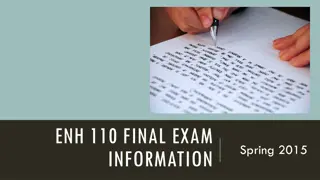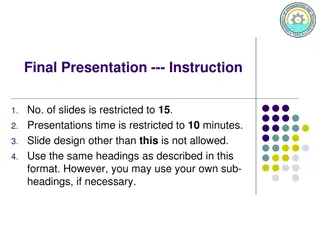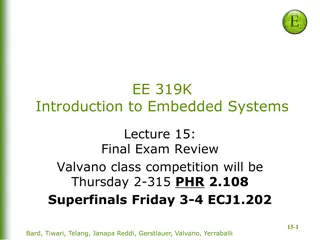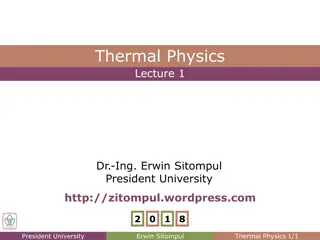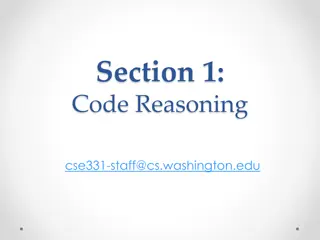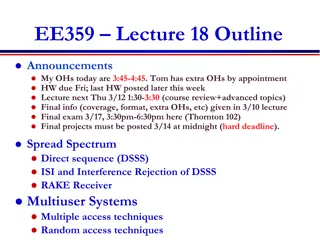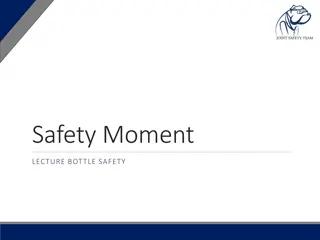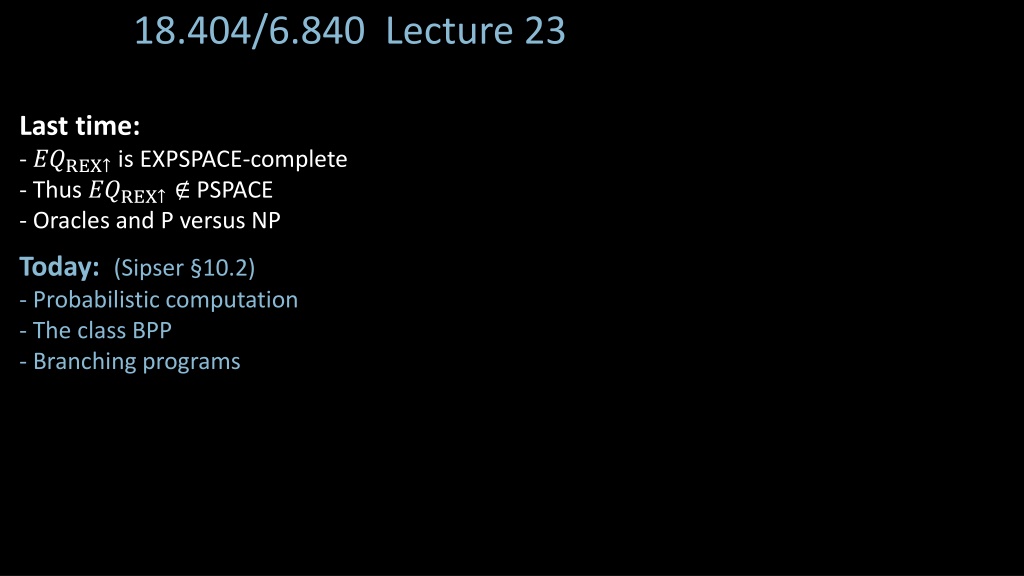
Probabilistic Computation and BPP in Complexity Theory
Explore probabilistic Turing machines, the class BPP, and branching programs in complexity theory, including the concept of error probability and the relationship between NP and BPP.
Download Presentation

Please find below an Image/Link to download the presentation.
The content on the website is provided AS IS for your information and personal use only. It may not be sold, licensed, or shared on other websites without obtaining consent from the author. Download presentation by click this link. If you encounter any issues during the download, it is possible that the publisher has removed the file from their server.
E N D
Presentation Transcript
18.404/6.840 Lecture 23 Last time: - ??REX is EXPSPACE-complete - Thus ??REX PSPACE - Oracles and P versus NP Today: (Sipser 10.2) - Probabilistic computation - The class BPP - Branching programs
Probabilistic TMs Defn: A probabilistic Turing machine (PTM) is a variant of a NTM where each computation step has 1 or 2 possible choices. deterministic coin flip step - each choice has 50% probability step computation tree for ? on ? Pr[ branch ? ] = 2 ? where ? has ? coin flips Pr[ branch ? ] Pr[ ? accepts ? ] = b accepts branch ? Pr[ ? rejects ? ] = 1 Pr[ ? accepts ? ] Defn: For ? 0 say PTM ? decides language ? with error probability ? if for every ?, Pr[ ? gives the wrong answer about ? ? ] ? i.e., ? ? Pr[ ? rejects ? ] ? ? ? Pr[ ? accepts ? ] ?.
The Class BPP 13 } Defn: BPP = ? some poly-time PTM decides ? with error ? = 12 then, Amplification lemma: If ?1 is a poly-time PTM with error ?1< for any 0 < ?2< Can strengthen to make ?2< 2 poly ?. 12, there is an equivalent poly-time PTM ?2 with error ?2. Proof idea: ?2= On input ? 1. Run ?1 on ? for ?times and output the majority response. Details: Calculation to obtain ? and the improved error probability. Significance: Can make the error probability so small it is negligible.
NP and BPP NP BPP Computation trees for ? on ? ? ? Few rejecting Many accepting 1 accepting Check-in 23.1 Which of these are known to be true? Check all that apply. (a) BPP is closed under union. (b) BPP is closed under complement. (c) P BPP (d) BPP PSPACE ? ? all rejecting Few accepting Many rejecting Check-in 23.1
Example: Branching Programs Defn: A branching program (BP) is a directed, acyclic (no cycles) graph that has 1. Query nodes labeled ?? and having two outgoing edges labeled 0 and 1. 2. Two output nodes labeled 0 and 1 and having no outgoing edges. 3. A designated start node. BP ? with query nodes ?1, ,?? describes a Boolean function ?: 0,1? {0,1}: Follow the path designated by the query nodes outgoing edges from the start note until reach an output node. ?1 1 0 Example: For ?1= 1, ?2= 0, ?3= 1 we have ? 101 = 0 = output. ?2 ?3 1 1 0 0 BPs are equivalent if they describe the same Boolean function. Defn: ??BP= ?1,?2 ?1 and ?2are equivalent BPs (written ?1 ?2) } ?3 ?2 ?1 0 1 1 0 0 1 Theorem: ??BP is coNP-complete (on pset 6) ??BP BPP ? Unknown. That would imply NP BPP and would be surprising! Instead, consider a restricted problem. 1 0
Read-once Branching Programs Defn: A BP is read-once if it never queries a variable more than once on any path from the start node to an output. Defn: ??ROBP= ?1,?2 ?1 and ?2are equivalent read-once BPs} Theorem: ??ROBP BPP ?1 1 0 Check-in 23.2 Assuming (as we will show) that ??ROBP BPP, can we use that to show ??BP BPP by converting branching programs to read-once branching programs? (a) Yes, there is no need to re-read inputs. (b) No, we cannot do that conversion in general. (c) No, the conversion is possible but not in polynomial-time. ?2 ?3 1 1 0 0 ?3 ?2 ?1 0 1 1 0 0 1 1 0 Not read-once Check-in 23.2
??ROBP BPP Theorem: ??ROBP BPP Proof attempt: Let ? = On input ?1,?2 1. Pick ? random input assignments and evaluate ?1 and ?2 on each one. 2. If ?1 and ?2 ever disagree on those assignments then reject. If they always agree on those assignments then accept. What ? to chose? If ?1 ?2 then they always agree so Pr[ ? accepts ?1,?2 ] = 1 If ?1 ?2 then want Pr[ ? accepts ?1,?2 ] so want Pr[ ? rejects ?1,?2 ] But ?1 and ?2 may disagree rarely, say in 1 of the 2? possible assignments. That would require exponentially many samples to have a good chance of finding a disagreeing assignment and thus would require ? > But then this algorithm would use exponential time. ?1 ?2 ?4 ?1 1 0 1 0 13 23 . 0 1 0 1 232?. Try a different idea: Run ?1 and ?2 on non-Boolean inputs.
Boolean Labeling Alternative way to view BP computation Show by example: Input is ?1= 0, ?2= 1, ?3= 1 The BP follows its execution path. Label all nodes and edges on the execution path with 1 and off the execution path with 0. Output the label of the output node 1. 1 ?1 1 0 1 0 0 1 ?2 1 ?2 1 0 Obtain the labeling inductively by using these rules: 0 1 0 0 0 ? 1 0 ?2 ?? 0 1 ?3 ?3 1 1 0 ?1 ?3 0 0 0 ? ?? ? ?? 1 0 ?1 ?2 ?3 0 1 1 0 Label edges from nodes Label nodes from incoming edges
Arithmetization Method Method: Simulate and with + and . ? ? ? ? = ?? ? 1 ? ? ? ? + ? ?? ?1 0 1 Replace Boolean labeling with arithmetical labeling Inductive rules: Start node labeled 1 ?2 1 ?2 1 0 0 ?2 ?1 ?3 ?3 1 ? ?3 ?? 0 1 1 0 0 ?1+ ?2+ ?3 ?1 ?2 ?3 ? (1 ??) ? ?? ? ?? ? ?? Works because the BP is acyclic. The execution path can enter a node at most one time. 1 0
Non-Boolean Inputs Use the arithmetized interpretation of the BP s computation to define its operation on non-Boolean inputs. Example: ?1= 2, ?2= 3 Output = 7 Recall labeling rules: 1 ? ?1 ?2 ?? 0 1 ?1 ?3 0 1 ? ?? ? (1 ??) 1 2 = 2 1 = 1 1 2 ?1+ ?2+ ?3 1 2 Check-in 23.3 What is the output for this branching program using the arithmetized interpretation if ?1= 1, ?2= ? ? (a) (1 ?) ?2 ?2 0 Revised ? for ??ROBP: On input ?1,?2 1. Pick a random non-Boolean input assignment. 2. Evaluate ?1 and ?2 on that assignment. 3. If ?1 and ?2 disagree then reject. If they agree then accept. (b) (? + 1) (c) ? 1 1 0 2 1 3 = 4 2 = 1 1 3 2 3 = 6 3 = 1 3 Correctness proof after Thanksgiving. 8 = 2 + 6 3 + 4 = 7 0 1 Check-in 23.3
Quick review of today 1. Defined probabilistic Turing machines 2. Defined the class BPP 3. Sketched the amplification lemma 4. Introduced branching programs and read-once branching programs 5. Started the proof that ??ROBP BPP 6. Introduced the arithmetization method



